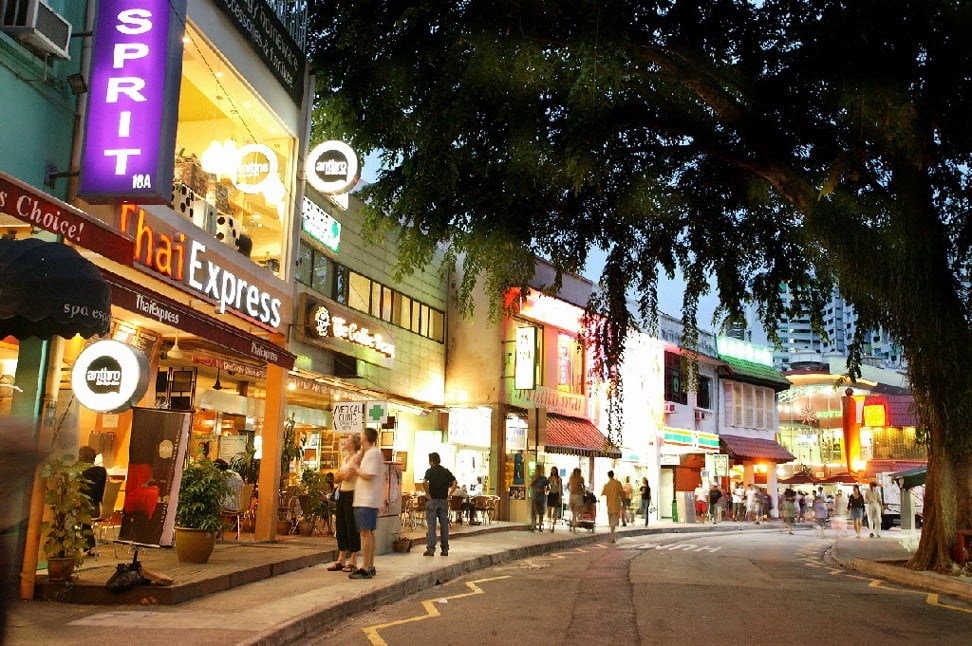Singapore’s luxury residential market is different from other major cities in Asia such as Manila, Jakarta, Bangkok and Hong Kong. The Lion City has an active public housing market, and private housing in mass residential and luxury sectors is also robust. Hence, some of the top HDBs, as public housing is known, are priced as much as the private housing in the same area.
Continuing our series on top luxury places to stay in regional cities, we take a look at Singapore and the top five areas to live in.
Holland Village
Approximate luxury apartment price: S$30 to S$45 million (HK$179 to HK$268 million)

Holland Village has a number of art galleries, art shops, novelty shops and pubs. Photo: Singapore Tourism BoardHolland Village is considered a Bohemian area to live in. The area is populated by a combination of the upper-middle class and rich Singaporeans and expats. It is tucked behind the Botanical Gardens and is minutes away from the busy Orchard Road. Holland Village features a number of art galleries, art shops, gift shops, novelty shops and pubs. There are private and public housing estates and gated housing communities.Five luxury property markets set to rise in 2017
Orchard Road
Approximate luxury apartment price: S$30 million and up

The view from the show flats of The Orchard Residences at Orchard Road, the busiest shopping street in Singapore. Photo: Sandy LiApart from being the commercial and shopping hub of Singapore, Orchard Road also has private residential housing.
Though Singapore isn’t a large country, there are a total of 28 numbered districts, each embodying and presenting very unique facets. Within them are the different regions that make up and in a way, define them.
For example, District 1 represents regions within the Central Business District (CBD), which also encompasses the popular integrated resort, the Marina Bay Sands. Do take note that the numbering, in no way represents the District’s importance.
In the past, these district numbers were used as postal codes. Houses in each district bear a postal code that starts with the same number as the district it’s in. While the postal code system has since changed, the numbering of each district remains, and is usually used for identifying areas of prime property these days.
The Regions and Districts have been listed below for your easy reference.
RESIDENTIAL DISTRICTS
District 1
Singapore’s financial hub is also known as the Central Business District (CBD). Many of the city-state’s popular tourist attractions are situated here, along with various financial institutions, banks and government offices, making it one of the most important districts in the country.
As skyscrapers and monumental structures of steel jostle for space, renovated and restored historic colonial buildings and warehouses still stand as a mark of the district’s humble beginnings.
Regions Include:
– Cecil Street
– People’s Park Centre
– Raffles Place
– Marina Bay
District 2
Another major part of the CBD, numerous skyscrapers housing well-known multinational corporations line the streets of District 2. Its development over the years has made it part of Singapore’s iconic skyline, though it’s hard to imagine that it used to be the site of small towns primarily focused on fishing.
Regions Include:
– Anson Road
– Tanjong Pagar
District 3
Known for its fruit and vegetable plantations, this district saw little to no development in the early 1900s. That soon changed as the expatriate population grew during British colonial rule. Housing projects sprung up to serve as offices and quarters, and are still around today, recognisable as restored and renovated colonial buildings. Developed as a major residential district, it’s no wonder its amenities are diverse and plenty.
Regions Include:
– Alexandra Road
– Queenstown
– Redhill
– Tiong Bahru
For those moving to Singapore with children, it’s reassuring to know that in the same survey it came first overall for ‘Little Expats’, which is made up of ease of making friends, learning and schooling.
If you’ve made the decision to move to this popular expatriate destination, top of your to-do list is securing suitable accommodation.
Singapore is split up into a number of Districts, and within these you can find some of the best neighbourhoods for professionals, couples and families.
There are a range of factors that might affect your housing options in Singapore. Budget is obviously the number one consideration, but house-hunters should also think about the facilities they would like to have access to, such as a swimming pool or a gym, as well as the distance to work, school and local amenities like the MRT, Singapore’s Metro.